The world is transitioning to electric vehicles (EVs). In order to do so, thousands of charging stations are needed. As with any emerging technology, a lot of new terminology and new processes must be learned. This article aims to simplify the world of EV charging with a deep dive into the terminology, statistics, and installation process for electric vehicle (EV) charging stations.
ELECTRIC VEHICLE HISTORY
Contrary to popular belief, EVs have been around for over 100 years. Per the Department of Energy, the first electric car — introduced in England in 1884 — quickly became popular alongside the internal combustion engine (ICE). By the early 1900s, EVs accounted for a third of vehicles sold in the United States. Like today, the earliest electric vehicles were viewed as a safe, clean form of transportation.
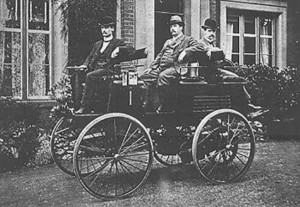
Circumstances quickly changed between the two world wars as the development and production of the ICE quickly advanced. As the oil market took off in the United States, gas vehicles became cheaper to buy and fuel. As a result, EVs slowly faded out of the limelight for several decades. There were a few attempts to re-spark EVs over the years, but none were successful in getting back into the mainstream market.
It was not until 2008 that EVs made a return to the mass market thanks to the introduction of the Tesla Roadster. After a century-long hiatus, EVs reentered mass production spurred by the popularity of the Tesla Model S, Nissan Leaf, and Chevy Volt.
Today, battery technology has accelerated significantly with many EVs now offering over 300 miles of range and the ability to charge in under 30 minutes. Equally important, battery costs have fallen sharply due to increased production and greater efficiency. These changes are creating more affordable EVs that are accessible to consumers of different income levels. In just ten years, over 2.5 million EVs have been sold in the United States alone according to Argonne National Laboratory. Many analysts predict EVs will continue to rise and return to a one-third market share in the next few decades.
THREE LEVELS OF CHARGING
There are three levels of charging speed. Each subsequent level is more powerful and therefore provides more range in less time.
Level 1 charging utilizes a 120-volt (V) wall outlet and provides 3 to 4 miles of range per hour of charging. Due to this slow charging speed, Level 1 charging is typically known as “trickle charging” and is primarily used overnight at residential locations. Since the typical commute of most drivers averages 40 miles, Level 1 charging is generally sufficient for daily trips.
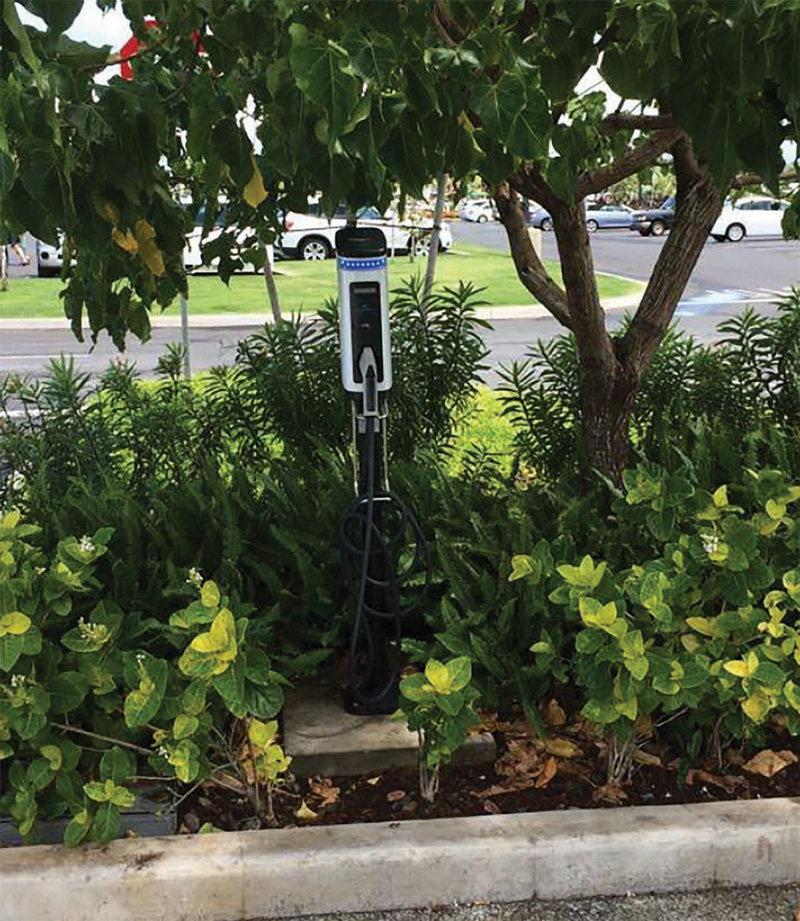
Level 2 Charging Station
Level 2 charging utilizes 208 V or 240 V and provides 12 to 40 miles of range per hour of charging. Delivering roughly the same amount of power as a typical electric stove, these stations can be installed using a NEMA 14-50 plug or hardwiring into an electrical system. Level 2 charging is used at residential, public, and commercial locations such as workplaces, retail, or hospitality sites. Level 2 charging is the most popular level of charging nationwide due to its readily available power and lower charging station cost. Many charging companies offer a wide range of Level 2 charging products for all types of use cases (e.g., apartments, fleets, workplaces, retail, and more).
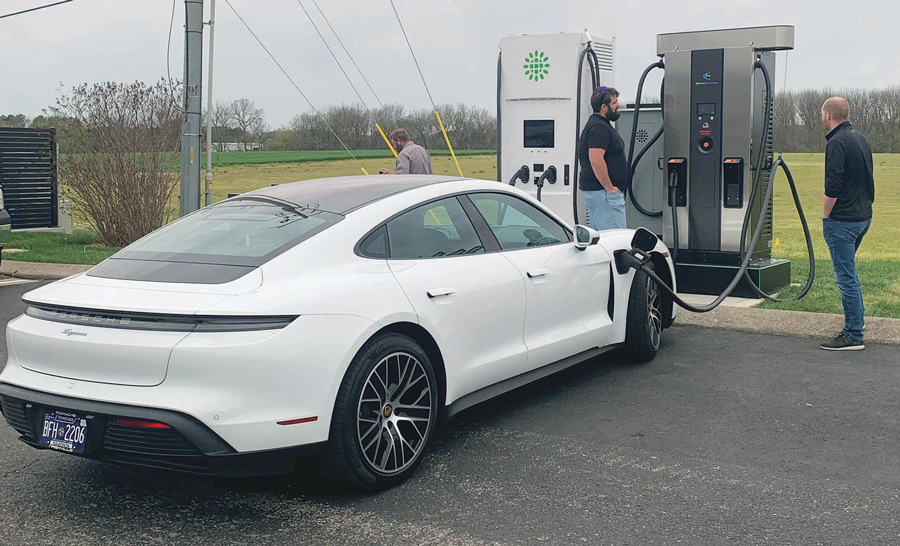
DC Fast Charging Station
Level 3 charging, more commonly known as direct current fast charging (DC fast charging or DCFC), utilizes over 400 V and provides a 10–80% state of charge in around 30 minutes. DCFC is exclusively installed at public and some commercial sites such as large fleet depots. Due to the higher voltage, DCFC is much more expensive than Level 1 or Level 2 charging stations and typically requires additional permitting.
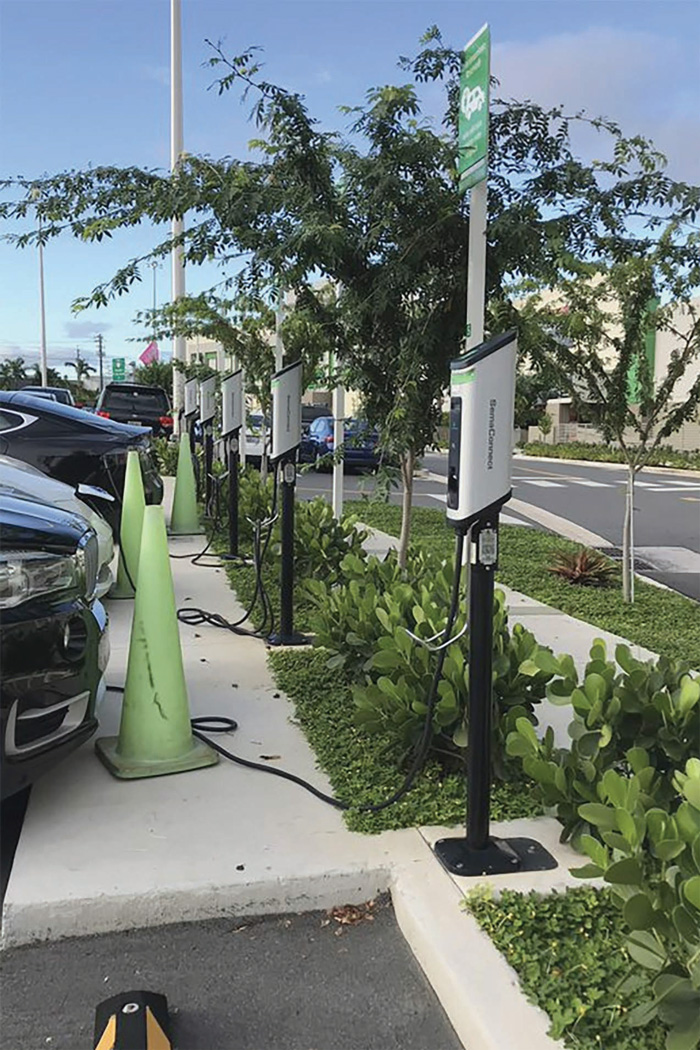
Level 2 Charging Station
In addition, not all electric vehicles can use a DC fast charging station. With Level 1 and Level 2 charging, the AC energy from the charging station is converted into DC energy by the vehicle’s onboard charger. DCFC stations bypass the onboard charger and directly add DC energy to the vehicle battery. While all plug-in hybrid electric vehicles (PHEV) and battery electric vehicles (BEVs) have the onboard charger necessary to use a Level 1 and Level 2 charging station, only BEVs can receive a charge from a DCFC station. Thus, while DCFC is by far the quickest way to charge an EV, it is not the right solution in every scenario.
EV CHARGING BY THE NUMBERS
EV charging infrastructure has grown steadily over the years. With dozens of network providers emerging over the past 10 years and millions of dollars of government funding, EV charging stations are now common in all sort of locations such as workplaces, metropolitan areas, shopping centers, apartment complexes, and interstate highway rest stops.
Per the Alternative Fuel Data Center, in 2011, when the latest generation of EVs entered the market, there were just over 2,100 station locations. Ten years later, there are over 50,000 station locations and over 130,000 ports. In fact, the number of charging station locations increased 37% year-over-year from 2020 to 2021.
Should this trend continue, there will be over 240,000 locations across the United States in just five years. Given the multi-billion dollar federal government investment in a national charging network, this could very likely be the case.
LOCATIONS AND USE CASE
The deployment of EV charging stations does not follow the same trend as gas stations. Despite what some believe, EV charging stations are utilized a bit differently due to the three levels of charging. Therefore, it is necessary to install the appropriate level of charging at the corresponding location. Matching the location and level of charging will eliminate unnecessary project costs. Ultimately, the use case will dictate which level of charging is required for that particular location.
For example, single-family residential, apartment complexes, and workplaces are locations suitable for Level 1 or Level 2 charging. This is because the vehicle dwell time is usually several hours. As a result, slower charging is acceptable as the driver is not in immediate need of the vehicle.
On the other hand, locations such as grocery stores, shopping centers, or highway rest stops are better suited for DCFC as the vehicle dwell time is usually around 30 minutes, which is the ideal length of time for a fast charging station. Conversely, if a Level 2 charger were installed at these locations, the EV would only gain around 15 miles of range, which would not be of much benefit.
PERMITTING AND UTILITY COORDINATION
Just as with any other construction project, permitting and utility approvals can often take several weeks, if not months, to advance. Cities and counties are almost always inundated with various public and private projects, and it can take a while to get through plan check. For example, Electrify America recently reported their typical permitting duration is around nine weeks. In California, this duration increases to around 12 weeks.
It is essential to work with the project engineer to ensure all code and local jurisdiction requirements are satisfied to eliminate the need for resubmittals. While an EV charging project is mainly electrical work, other building code sections such as parking, signage, and accessibility are involved.
Electric utility companies are also busy with various new and existing service projects. Electrify America also reported that typical utility approvals take 38 weeks. Fortunately, not all EV charging projects require utility approvals. It is best to check with the project engineer or contractor to evaluate whether the electric utility company is needed for the project.
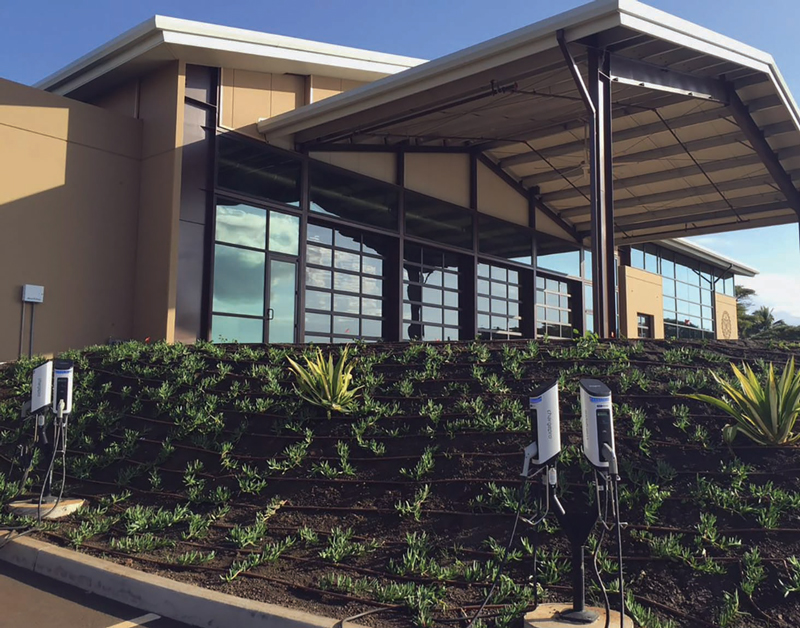
Workplace Parking Stations
CHARGING STATION NETWORK OPERATORS
Just as there are a number of charging station network operators, there are several ownership models for EV charging. For example, Tesla and Electrify America serve as charge point operators (CPO) where they own, operate, and maintain the chargers. This type of model is effective for large commercial sites with a steady stream of EV drivers.
On the other hand, companies such as Blink and SemaConnect sell equipment and networking services, leaving site operations and charging station maintenance to the site host. This type of model is ideal for locations where the property owner wants to collect charging revenue and maintain control of charging operations. Locations such as apartments, condominiums, and workplaces best fit this model.
In any case, charging stations require a decent amount of planning, engineering, and management throughout the project lifecycle. It is critical to assemble a team of specialists to ensure the project goes smoothly throughout each phase.
INTEROPERABILITY
Interoperability can take on several meanings in the EV charging industry. To some, it means an open network. To others, interoperability means roaming agreements. Organizations include CharIN, a global membership dedicated to the advancement of interoperability based on the Combined Charging System (CCS) standard; the Open Charge Alliance, which develops the Open Charge Point Protocol (OCPP) to promote network interoperability; and the OpenADR Alliance, which develops the Open Automated Demand Response standard to promote interoperability between utilities and charging networks. These organizations work to streamline the process to make charging easier for station owners and EV drivers.
Open Networks
Open networks allow station owners to mix and match hardware and software from different vendors. This provides flexibility, as site hosts can choose from a number of hardware options and have a single cloud account for software/back-end.
Open-networked charging stations offer easy installation and repair, making them the preferred option for many site hosts. With OCPP, station owners are not locked into a single hardware solution if they need to replace a station integrated within their charging network. Open networks also allow site hosts to switch networking providers altogether should they be dissatisfied with service or their provider goes out of business. Open-networked charging stations may be designed by companies that only offer hardware or by companies that offer both hardware and network connectivity.
Closed Networks
With a closed network, site hosts must select specific hardware that is compatible with the networking provider. Closed networks do not offer the flexibility of open networks, which means that if a site host wants to switch network providers, they must also switch to new networked charging station hardware.
The main benefit to closed networks is that the network is seamlessly integrated with the hardware. The network is often limited to a single or just a few pre-selected hardware manufacturers. As a result, the hardware and software work seamlessly together.
Roaming Agreements
Some EV charging networks offer roaming agreements to allow EV drivers to access multiple networks through the charging smartphone app of their choice without joining each network’s membership program. This helps streamline the charging process, which ultimately improves the experience. Roaming agreements are becoming more common as the industry is making an effort to provide EV drivers with the easiest way to find and access charging stations.
TYPICAL INSTALLATION COST
Like other construction projects, EV charging projects can vary wildly. A number of factors play a large role in determining the amount of capital required. These factors include, but are not limited to:
- Design and engineering
- Charging level
- Property location
- Prevailing wage requirements
- Infrastructure upgrade requirements
- Location of charging spaces relative to the electrical panel
Subsequently, the cost of each project installation is unique.
According to a 2019 study on EV charging installation costs by the International Council of Clean Transportation, in addition to the cost of the charging station, site hosts can expect to pay approximately $2,305 to $4,148 to install a Level 2 charger and around $45,506 to $65,984 for DCFC. The cost for the actual charger is around $596 to $3,147 for Level 2 and around $28,401 to $140,000 for DCFC.
These figures do not include rebates or other incentives, which can significantly reduce the total installation cost. In fact, rebates can reduce project costs by as much as 100%. It is highly recommended to research available incentive programs while planning the project.
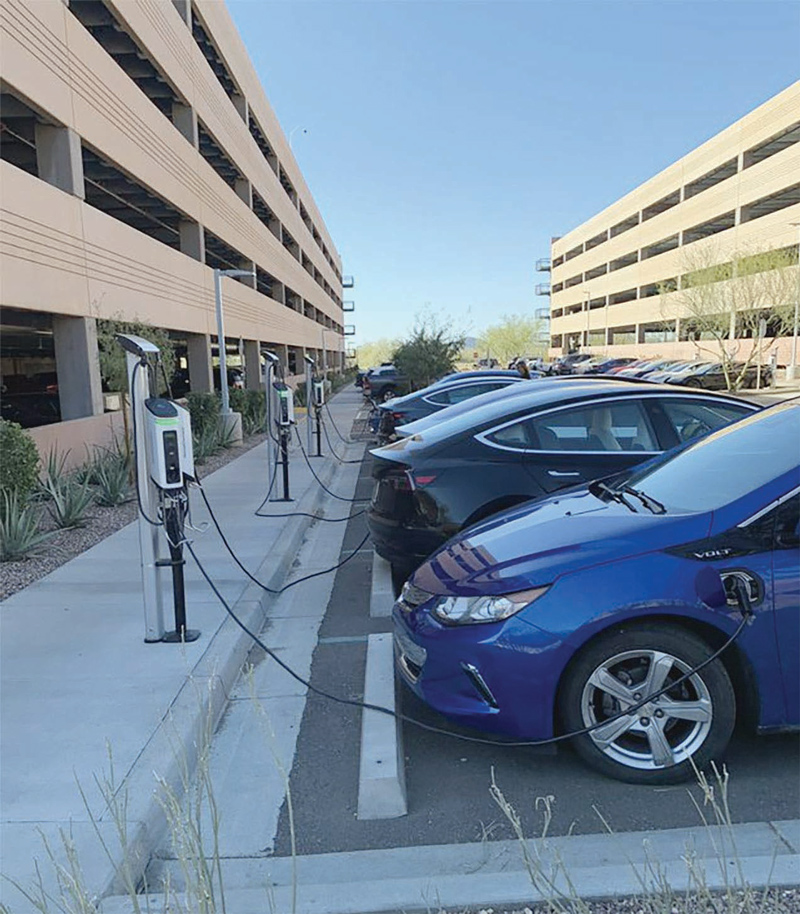
Charging Stations with Exposed Cables
OPERATION AND MAINTENANCE
The operation of a charging station can mostly be done remotely thanks to the networking system. In fact, most issues that arise with a charging station can be resolved by a software restart or over-the-air update. Any changes to the pricing schedule, hours of operation, or access groups can be modified through the network portal website.
EV charging stations require minor on-going maintenance over the years to ensure proper operation. While much of the equipment is stationary, the cable and plug are used hundreds, if not thousands, of times per year. At charging stations that do not use a cable management system, cables may be left on the ground where they can cause a tripping hazard or be damaged by vehicles.
Additionally, plugs should be cleaned on a regular basis to ensure the charging pins are free of any debris, as this can result in a poor connection with the EV.
THE FUTURE OF EV CHARGING
As the world races towards transportation electrification, large investments in EV charging infrastructure will be needed over the next few decades. Similar to the 1950s rollout of the interstate highway system, national EV charging infrastructure is set to be a massive capital project.
In 2021, the International Energy Agency’s Energy Efficiency 2021 report shared that the number of charging ports increased 40% from the previous year. Charging networks have never been as active as they are today. Properties of all kinds are investing capital in EV charging as the market prepares for an electric future. Given the record pace of EV sales in the first quarter of 2022, infrastructure spending is expected to increase for the foreseeable future.
Furthermore, the federal government recently passed the Infrastructure Investment and Jobs Act (IIJA), which includes $7.5 billion dollars for EV charging infrastructure. IIJA also includes several hundred million dollars for maintaining and upgrading the electrical grid, which is essential for the country to make the switch to EVs. Couple this with the already fast rate of EV charging expansion, and the U.S. should expect to see a dramatic increase in the number of stations and ports available for use.
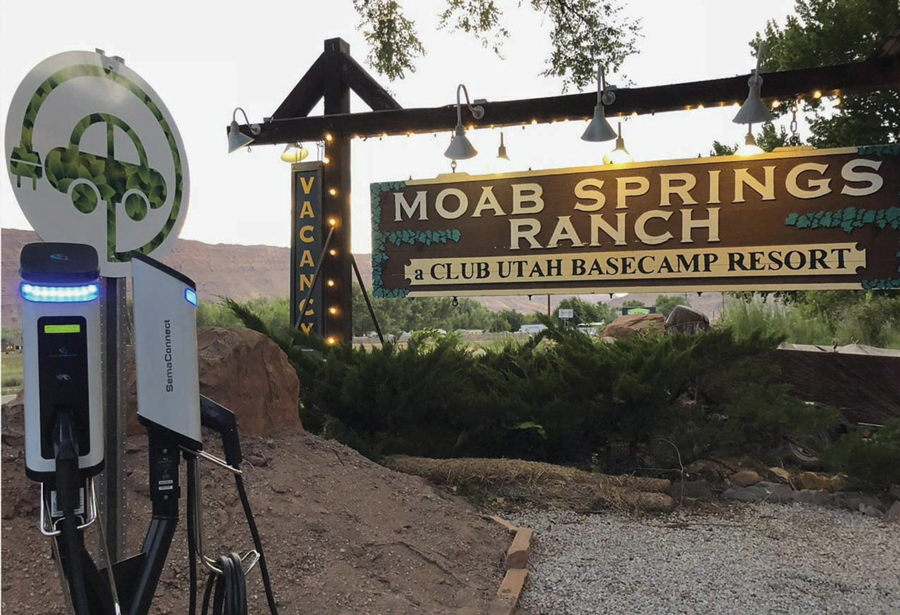
Charging stations are appearing everywhere.
WHAT DOES EV CHARGING MEAN FOR NETA COMPANIES?
As an electrical project, EV charging is a large opportunity for NETA companies. The rollout of EV charging requires infrastructure such as additional generation, transformer upgrades, distribution equipment, switchgear, project installation, and much more. Additionally, many CPOs will be looking for trusted partners to perform preventative maintenance and testing on infrastructure to ensure continuity of service as well as safety to drivers and operational personnel.
As a result, trusted NETA companies can perform this work and ensure the project is completed per the appropriate procedure, quality, and safety standards. With tens of thousands of EV charging stations planned over the next few decades, NETA companies can look forward to performing this work to sustain and increase business operations.
 Tony Sargent is the Senior Vice President of Sales at SemaConnect, a leading manufacturer of EV charging hardware and software located in Bowie, Maryland. Prior to joining SemaConnect, Tony began his career at Eaton Corporation’s Electrical Products Division in various sales and project management roles before starting his 12-year career at CE Power Solutions in 2009. During his career at CE Power Solutions (Qualus Power Services), Tony was responsible for leading sales, marketing, and acquisitions. During this time, Tony was an active participant in NETA. He received his BS from Miami University and an MBA from Xavier University.
Tony Sargent is the Senior Vice President of Sales at SemaConnect, a leading manufacturer of EV charging hardware and software located in Bowie, Maryland. Prior to joining SemaConnect, Tony began his career at Eaton Corporation’s Electrical Products Division in various sales and project management roles before starting his 12-year career at CE Power Solutions in 2009. During his career at CE Power Solutions (Qualus Power Services), Tony was responsible for leading sales, marketing, and acquisitions. During this time, Tony was an active participant in NETA. He received his BS from Miami University and an MBA from Xavier University.
